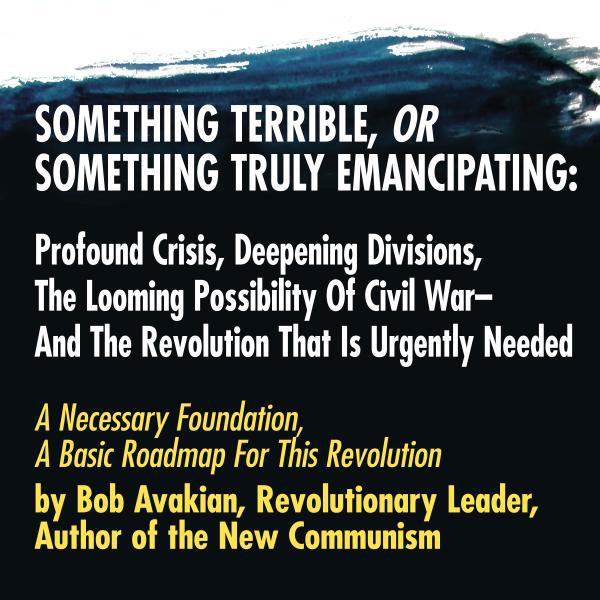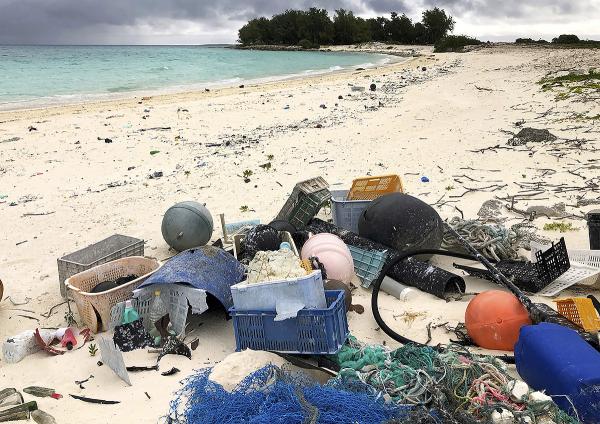
The parasitic consumer economy in the U.S. and other imperialist countries massively produces plastics, which are dumped onto the land and into the ocean, and are doing great damage to biodiversity. Photo: AP
The global capitalist-imperialist system is endangering life on the planet. Through the system’s “business as usual,” through climate change, through wars that devastate not just human but also plant and animal life... many living things are being killed off, whole species driven to extinction. And this is accelerating. The planet today confronts an ominous decline in biodiversity. This is one more urgent reason we need to get rid of this system.
Part 1: The Biodiversity Crisis
Biodiversity refers to the vast number of different kinds of life that exist in one area. The biodiversity crisis cuts deep into the heart of the way life has developed on this planet, and it is doing great damage that cannot be easily repaired:
- The number of many kinds of animals and plants is drastically declining. For animals that live in the world’s rivers and lakes, scientists estimate that more than four out of five frogs, fish, and other life once in those waters are gone.1 For insects, critical to the survival of plants and animals, half are gone.2
- It is not just that numbers are declining dramatically, but whole species are going extinct. The tremendous variety of species is the product of billions of years of evolution. As many as a million species of animals now face the threat of extinction—for example, nearly a quarter of the mammals. Once a species is gone, it is gone forever.
- Further, whole ecosystems (interrelated life systems in an area) are under threat of collapse. One extremely important example is the Amazon rainforest, the biggest forest and biggest source of biodiversity on the planet. This is in serious danger, being cut down and burned to make way for mining, agriculture, and other capitalist development. Another important example is the coral reefs, the richest source of biodiversity in the ocean, which are under severe threat because climate change has heated the ocean and made it more acidic, and this threatens the marine organisms that make coral.
- The web of life on the planet as a whole is one, very complex, ecosystem that includes many smaller ecosystems, and this, too, could collapse, which would mean radical changes in life on the planet.
In the long history of life on earth, populations go up and down, species die off, and there have been some great mass extinctions. Many scientists think that what is happening to the planet now could be the sixth great mass extinction—the biggest since the death of the dinosaurs (and about half of all existing plant and animal species) 66 million years ago—this time caused by human beings (organized in a capitalist system), not by something like a giant meteor from space.
Human society rests on the foundation of the natural world, it needs the “life support system” of that whole web of life, and cannot exist without it. The oxygen we breathe comes from this web, from forests on the land and from plants, some of them microscopic, in the sea.
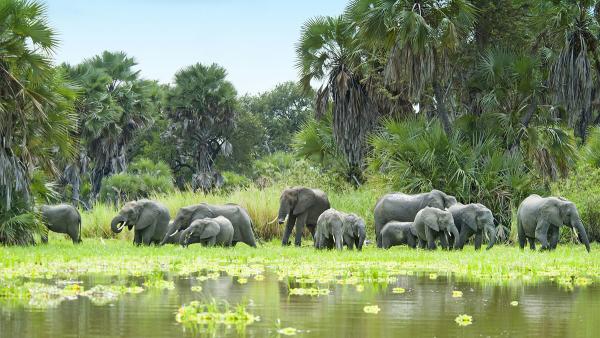
The Selous Game Reserve in Tanzania, shown here, is under threat from pressure for uranium mining.
Capitalism, Biodiversity, and Climate Change—and the Outsize Role of the U.S.
The unplanned, exploitive and irrational development of global capitalism is the engine of the destruction of biodiversity. A big factor in the assault on biodiversity is the expansion of imperialist, capital-intensive agriculture including in the Global South (the countries of Africa, Asia, Latin America and the Middle East dominated by imperialism). This has driven the cutting down of rainforests and destruction of habitat and environment for wild animals and plants.
The hand of U.S. imperialism, directly or indirectly, is disproportionately involved when rainforests are cut down; when marshlands are flooded with oil in Africa and Latin America; when sea life is fished to the verge of extinction all over the world; when wars devastate the countryside. The parasitic consumer economy in the U.S. and other imperialist countries massively produces plastics, which are dumped into the land and oceans, and are doing great damage to biodiversity, literally strangling fish, birds, and other life. Plastics are present in the air at the top of Mount Everest and in the water in the Mariana Trench, the deepest part of the ocean. The U.S. is the world’s largest generator of plastic waste, by far.3
The Global South is where the loss of biodiversity is the greatest. Look at the Democratic Republic of the Congo (DRC), one of the centers of biodiversity in the world. The area which is now the DRC has been ripped apart and dominated by imperialism, going back centuries. Today, its “protected” forests are being illegally cut down for a global market ultimately dominated by the imperialist countries, especially the U.S. There are rich, strategically-important cobalt mines, some in environmentally threatened areas of the DRC. And right now there is a big struggle between the two largest capitalist-imperialist economies in the world, China and the U.S., over control of the mines and of the DRC.
The imperial powers are NOT struggling over who can better protect the environment, they are struggling for dominance and control of a strategically important mineral, environment be damned. There are an estimated 120 armed groups inside the DRC working under the allegiance of different imperialist powers, regional governments, and other groupings that the government does not control. Endangered species, like chimpanzees, are under threat. The lives and livelihoods of indigenous people living in the forests are under threat—and that threat will only intensify as long as the current power relations on the ground, and the global imperialist order that enforces and exploits all that, continue.
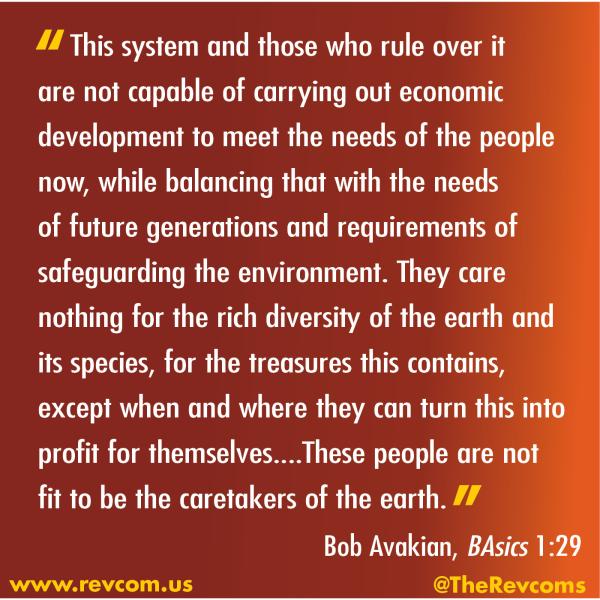
Climate change is another big factor in the threat to biodiversity: heating up the air and water, melting polar ice caps, and generally changing conditions so that many plants and animals are unable to thrive as they have in the past. And vast ecosystems are under stress or may not even be able to survive. And again, the U.S. is the biggest single contributor to climate change—it is number one historically in burning fossil fuels and injecting carbon dioxide, the main gas that is causing global warming, into the atmosphere.
Part 2: Radical Change Urgently Needed... and This System Stands in the Way
To stop the assault on biodiversity—and to work to undo much of the great damage that has already been done—will take a radical economic restructuring of global economic, political, and social life. No more destroying rainforests in Indonesia to make palm oil plantations to profit international capital based in the U.S., Western Europe, and other imperial centers... no more ripping up biodiversity hot spots in Africa to mine cobalt for batteries for Silicon Valley’s computers and cell phones... no more U.S.-dominated network of international, profit-driven “supply chains” which themselves damage the environment and are major contributors to climate change... no more plastics-spewing parasitic consumer culture; no more imperialist-driven wars that destroy people and the environment.
CONSTITUTION For The New Socialist Republic In North America (Draft Proposal)
Authored by Bob Avakian, and adopted by the Central Committee of the RCP (PDF)
Also:
Read and download the PDF
Stopping climate change is crucial and urgently needed if we are to have a chance to stop the assault on biodiversity. This, too, means wrenching changes: slashing carbon emissions; ending production of electric power from burning fossil fuels; reorganizing the global economy so that transportation, industry, housing, and more are not dependent on burning fossil fuels.4
What is urgently needed is global cooperation and people looking out for each other while working together all over the planet to tackle the environmental crisis and climate change. But what the rule of imperialism gives us is intensifying plunder and destruction of crucial centers of biodiversity, savage wars, and a rise in fascist political power including in the U.S. itself.
The Long and Shameful History of Abysmal Failure by the Major Governments of the World
The biodiversity crisis is not some new discovery. Biologists have been sounding the alarm for decades. Thirty years ago, international conferences to address biodiversity issues were initiated with the Convention on Biological Diversity. But take note: this agreement to at least formally acknowledge and address dangers to biodiversity has been signed by every government on earth... except two: the U.S. and the Vatican. The U.S. was, and remains, incapable of even promising to deal with the biodiversity crisis!
The Convention on Biological Diversity, and the global talks and agreements that have followed, have not stopped the acceleration of the destruction of biodiversity. In the 2002 international convention, the governments agreed to achieve a reduction in the rate of biodiversity loss. This did not happen, biodiversity loss accelerated. At the big global meeting on biodiversity in 2010 in Aichi Japan, 20 targets were adopted—in all the years since, not a single one of the targets they agreed on were met—the world’s governments and ruling classes failed on every single point. This pathetic track record was the backdrop to the latest such gathering in Montreal, Canada.
The Sham of the December 2022 Biodiversity Conference
The latest biodiversity conference—called COP15—concluded with the claim to achieve a “historic breakthrough”: passage of a statement in which governments agreed to protect 30 percent of land and water areas by 2030 (referred to as 30x30).5 But this triumphal claim—and by the way, these agreements are not legally binding—covers over a program of continuing with “business as usual.”
Reality check:
- In the real world, “protected areas” do not protect biodiversity on the scale and with the urgency required. Since 1970, more and more land has been declared “protected”—but the rate of species decline has intensified.6
- Many of the “protected areas” which already exist are so small that there is no room for animals to roam or forests to grow, so they “protect” in name only.
- Some protected areas that existed before the December 2022 conference are now being destroyed under the military and economic demands of globalized capitalism. The Selous Game Reserve in Tanzania is under threat from pressure for uranium mining. The Viracehy National Park in Cambodia is earmarking vast areas for rubber plantations.7
Over 1,700 environmental and land defenders have been killed in the last decade.8 The majority of those murdered have been from among indigenous peoples of the Global South.
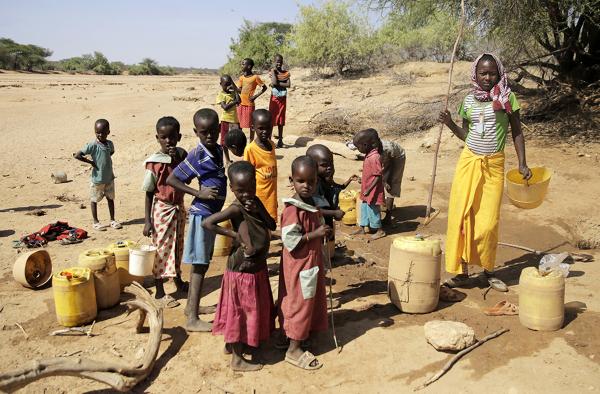

In drought-stricken Kenya, children fetch water from ground water well. Photo: AP
The Urgent Need for Revolution Now
The crisis in biodiversity is one more way in which humanity is at a precipice. We have to confront the reality that this system of capitalism-imperialism cannot be allowed to dominate and devastate the planet any longer. And there is a revolutionary way out... there is a strategy for making revolution and a plan and blueprint for transforming human society's relationship to the planet. That vision of a different future is contained in the Constitution for the New Socialist Republic in North America, authored by Bob Avakian, in Some Key Principles of Socialist Sustainable Development, and many other articles on revcom.us including those in the special resource page on the environment. We have a solution—there is a real way out for humanity—through revolution and socialism, which gives us the only real framework, and the real chance, to put an end to the horrific devastation of the planet caused by capitalism.
This revolution to emancipate all of humanity can unleash people, their passions, their ideas, the science, and enable us to go work collectively on this crisis, as caretakers of the planet—and forge a radically new, a truly sustainable, relationship between human society and nature.
We are in a rare time when revolution in the U.S. is not only urgently needed, but more possible. All who want to actually do something real to stop the destruction of the environment should take up the battle to put revolution on the map in 2023, to prepare for coming storms.
Glossary
Species: The basic unit or kind of life. A biological species is a group of organisms that can reproduce with one another in nature and produce fertile offspring. There are millions of species on the planet. Charles Darwin, the scientist who developed the understanding of the evolution of life and wrote the book Origin of Species, spoke of life as “endless forms, most beautiful.”
Ecosystem: An ecosystem is a system in which a huge number of plants, animals, fungi, and microscopic organisms live together in a complex tangle of relationships, dependent on each other, in an area. Ecosystems can collapse—this can happen because key species that hold a system together get wiped out, because of ecosystems being destroyed like forests being cut down for farms, or for many other reasons.
Biodiversity: Biological diversity measures the vast number of different kinds of life that exist in one area. This includes different species, but also groupings that include many species, like plants, animals, fungi and one-celled forms of life. All these forms have evolved over billions of years, and live in mutual dependence in a complex web. The planet today confronts an ominous decline in biodiversity.


